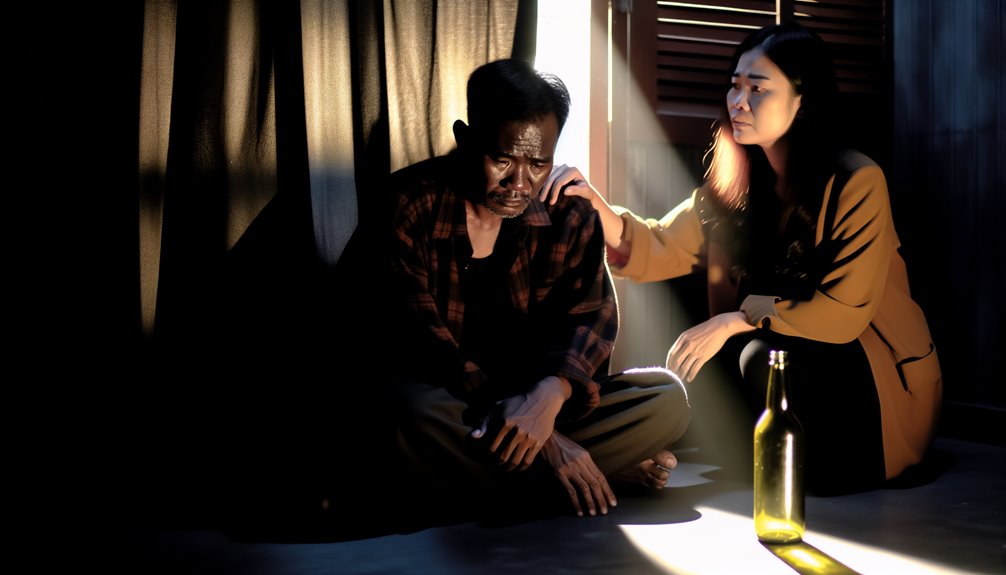When you commence the journey of recovery, family therapy becomes an essential ally. It helps you and your loved ones communicate openly and strengthens emotional ties, creating a nurturing environment. By participating together, you’ll learn to address conflicts with empathy and understanding. This shared process not only identifies triggers but also fosters accountability, paving the way for a harmonious home and a reduced chance of relapse. Curious about how this unfolds further?
Understanding the Role of Family Dynamics in Recovery
When it comes to recovery, understanding family dynamics is essential because these relationships greatly influence the healing process. As you begin to navigate this journey, recognizing the various family roles that exist can be incredibly helpful. Each member often plays a unique part—whether they’re the caregiver, peacekeeper, or even the one in need of support.
These roles can either facilitate or hinder your healing, depending on how they’re expressed. You’ll find that emotional support from your family is a vital element in recovery.
It’s important to foster an environment where feelings can be openly shared and validated. By understanding these dynamics, you’re better equipped to harness the positive aspects of your family’s influence, making the path to recovery smoother and more supportive.
Enhancing Communication and Building Trust
How can open communication transform your family’s recovery journey? It fosters understanding and closeness.
By practicing active listening, you show empathy and make everyone feel heard. Emotional validation conveys that you respect each family member’s feelings, strengthening bonds and trust.
Here’s how you can enhance communication and build trust:
- Practice Active Listening: Give full attention when someone speaks, showing you value their words and feelings.
- Encourage Emotional Validation: Acknowledge each other’s emotions without judgment, creating a safe and supportive environment.
- Set Regular Check-ins: Schedule time to discuss feelings and experiences, maintaining open lines of communication.
- Create a Judgment-Free Zone: Allow honest expression without fear of criticism, promoting deeper connections.
These steps can guide your family towards a supportive recovery.
Conflict Resolution Techniques for Families
In addressing family conflicts, you can benefit from using effective communication strategies that foster understanding and connection.
It’s important to identify underlying issues that may be fueling disagreements, allowing you to address the root causes rather than just the symptoms.
Establishing healthy boundaries will create a safe space for everyone, leading to more respectful and productive interactions.
Effective Communication Strategies
Though conflicts are a natural part of family life, effective communication strategies can transform these challenges into opportunities for growth and understanding.
To foster healthy communication, focus on the following:
- Practice Active Listening: Show genuine interest by giving your full attention, nodding, and asking clarifying questions. This illustrates empathy and respect.
- Be Mindful of Nonverbal Cues: Your body language, facial expressions, and tone can speak volumes. Confirm they align with your words to avoid misunderstandings.
- Use “I” Statements: Express your feelings and needs without assigning blame. This encourages open dialogue and reduces defensiveness.
- Establish Ground Rules: Agree on guidelines for discussions, like taking turns speaking and avoiding interruptions, to create a safe space for everyone.
These strategies promote a harmonious family environment.
Identifying Underlying Issues
When conflicts arise, uncovering the root causes is essential for lasting resolution. You might find that underlying trauma or emotional triggers are at the heart of many family issues. By addressing these hidden factors, you can foster a deeper understanding and create an environment where healing can begin.
It’s important to approach these discussions with empathy and patience, as these topics can be sensitive and challenging to explore.
Family therapy can help you identify these underlying issues by providing a safe space to express feelings and experiences. A therapist will guide you in recognizing patterns and behaviors linked to past trauma or emotional triggers, facilitating meaningful conversations.
Establishing Healthy Boundaries
Steering through family dynamics can be challenging, but establishing healthy boundaries is essential for fostering harmonious relationships.
You might feel guilty or unsure about boundary setting, yet it’s vital for everyone’s well-being. Healthy boundaries respect personal space and help prevent misunderstandings.
Here are a few steps to help:
- Communicate Clearly: Express your needs directly and kindly, ensuring your family understands why boundaries matter.
- Be Consistent: Uphold boundaries consistently to reinforce their importance and encourage mutual respect.
- Respect Others’ Boundaries: Show empathy by honoring others’ personal space, setting a positive example.
- Seek Support: Family therapy can offer guidance and tools for effective boundary setting and conflict resolution.
You deserve relationships that nurture and respect your personal space.
Creating a Supportive Environment for Healing
Creating a supportive environment for healing begins with open communication, where you and your family can express yourselves honestly and listen actively.
As you work together, it’s essential to share responsibilities, making each family member feel valued and involved in the recovery process.
Building Trust Through Communication
Although building trust might seem challenging, effective communication in family therapy can transform relationships and pave the way for healing.
You can create a supportive environment by focusing on active listening and emotional validation. Here’s how:
- Practice Active Listening: Pay full attention when a family member speaks. Show them that you genuinely hear their concerns.
- Provide Emotional Validation: Acknowledge and accept their feelings, even if you don’t agree. This fosters a sense of safety and understanding.
- Express Empathy: Use empathetic language to show compassion and support, reinforcing the trust within the family.
- Encourage Open Dialogue: Promote honest conversations without judgment. This openness encourages healing and strengthens familial bonds.
These steps help you build trust, creating a nurturing space for recovery.
Encouraging Shared Responsibility
When families embrace shared responsibility, they cultivate a collective strength that fuels the healing process.
You play an essential role in fostering an environment where everyone feels valued and accountable. Shared accountability means each family member contributes to the recovery journey, recognizing their impact on collective healing.
This approach not only lightens the individual burden but also reinforces unity and resilience. By encouraging open dialogue, you guarantee everyone’s voice is heard, promoting transparency and trust.
Establishing clear roles and expectations helps prevent misunderstandings and fosters cooperation.
The Impact of Involving Family Members in Therapy
Involving family members in therapy can profoundly impact the recovery process, offering both emotional support and a deeper understanding of the challenges faced.
When family involvement is encouraged, you build stronger therapeutic alliances, enhancing communication and trust. Here’s how it can help:
- Shared Support: Family members provide a network of encouragement, which can be essential for maintaining motivation and resilience during recovery.
- Increased Understanding: By participating, families learn about the recovery process, helping them empathize and connect more deeply.
- Improved Communication: Therapy sessions can teach effective communication skills, reducing misunderstandings and fostering healthier relationships.
- Accountability: Family members can help monitor progress, ensuring that you stay on track and committed to your recovery goals.
Engage your family, and you’ll find strength together.
Long-Term Benefits of Family Therapy in Recovery
Family therapy offers long-term benefits that extend beyond immediate recovery, creating a foundation for sustained well-being.
You’ll notice how the long-term effects foster stronger family connections, allowing individuals to feel more supported and understood. This therapeutic approach builds family resilience, equipping everyone with the tools to handle future challenges together.
As you work through issues, communication improves, and empathy grows, reducing conflicts and promoting a harmonious home environment.
Family therapy encourages open dialogue, helping you and your loved ones address underlying issues that might’ve contributed to past struggles.
The skills you learn are invaluable, transforming the family unit into a source of strength and stability. Over time, these changes contribute to a healthier, more supportive recovery journey for everyone involved.
Frequently Asked Questions
How Do Family Roles Change During the Therapy Process?
During therapy, you’ll notice family role dynamics evolving. Members might step out of traditional roles, leading to significant communication shifts.
You’ll feel supported as you explore these changes together, fostering a more understanding and empathetic environment. It’s common for roles to become more balanced, allowing everyone to express themselves freely.
What Qualifications Should a Family Therapist Have?
When searching for a family therapist, you’ll want to guarantee they meet specific licensing requirements and possess the right therapist credentials.
Look for someone who’s licensed in your state, which typically means they’ve completed a master’s or doctoral program in counseling or psychology. They should also have experience in family systems therapy.
Don’t hesitate to ask about their credentials and experience. This guarantees you’re getting the support you need from a qualified professional.
Can Family Therapy Be Effective for Nontraditional Family Structures?
Absolutely, family therapy can be effective for nontraditional dynamics.
Whether you’re part of blended families, single-parent households, or same-sex parent families, therapy offers tailored support.
It recognizes your unique challenges and strengths, offering tools to improve communication and resolve conflicts.
Therapists understand that every family is different and they adapt their approach to suit your particular situation, ensuring that all members feel heard and valued in the healing process.
How Often Should Family Therapy Sessions Occur During Recovery?
When considering how often family therapy sessions should occur during recovery, it’s essential to tailor the session frequency to your unique recovery timeline.
Initially, weekly sessions might be beneficial to build communication and trust. As you progress, you might shift to bi-weekly or monthly sessions, allowing you and your family to integrate what you’ve learned.
Are There Specific Therapies Tailored to Different Family Cultures?
You’re probably wondering if there are therapies tailored to different family cultures. Absolutely, there are!
Therapists practice cultural sensitivity by adapting therapy methods to fit diverse family backgrounds. They’ll consider cultural values, communication styles, and family dynamics.
These therapy adaptations guarantee that each family feels understood and respected. It’s essential to choose a therapist who acknowledges your cultural identity and provides a supportive environment for your family’s unique journey.



